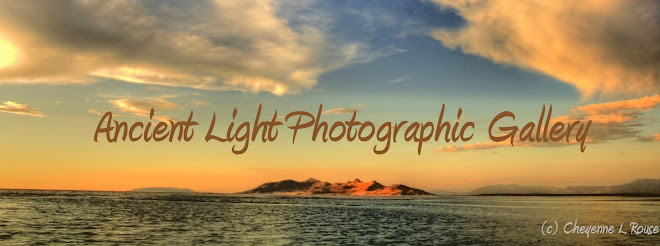 Chasing Light
Chasing Light© Cheyenne L Rouse
When people used to ask me what I did for a living I said, “Well, I chase light for a living” and of course they always looked at ime like I was crazy – ok, maybe I am but there was a method to my madness when it comes to light. Light can make or break a photograph – if you have flat dull lighting then the result is of course, a flat, dull picture – unless you know some tricks of the trade to work with. If you have warm dramatic light then you have a PHOTOGRAPH!! I would (and still do) chase light until I found DRAMA – to me a photograph should evoke emotion and that is what I worked for – color, drama and emotion. Here are some basic lighting tips that might help you find the drama too.
Direct Sunlight Natural light
is usually the best type of light source. Since the sun is the source of all natural light, it is important to understand that there is no such thing as "bad sun light" in a photo; you just need to learn how to use the available light rather than fight it. For example, direct sunlight is a very hard light that creates more shadows and extreme contrast levels between light and dark colors. This could be great for a black and white photo, but maybe not for a color portrait. So, if direct light will not work for you, you can try to diffuse the light by partially blocking it with a sheet or a diffuser, which is a piece of equipment most pro photographers carry. Or, you can find some shade to place your subject in.
Overcast Sunlight or Window Light
Contrary to direct sunlight, an overcast sky or light from a window will give a softer, more diffused light to your photo. You will see less of a contrast between black and white colors with this kind of light. Many photographers prefer overcast light to direct sunlight because it is generally easier to work with, especially if you are photographing people (people also tend to squint in direct light).
Experiment with Different Kinds of Light
The only way to really understand what different types of light does to your photos is to get comfortable shooting in all kinds of light. For example, go outside and take a shot of someone or something in the direct sun (no shade). Then, place the same subject in an open shaded area and take the shot. Try again on an overcast day, and try a shot in the direct sun but using a sheet or diffuser to block the light coming into the shot. Also, try "bouncing" the light by using light that is reflected off a building as your main light source. See how many different light scenarios you can photograph, then go back and examine the effect on each picture. This will give you a great understanding of what different light does to your pictures: how it affects the tone/mood, the color contrast, and other elements in the photo. Also, pay attention to how different light changes the color temperature of the photo. Is there a shift in color from one photo to the next? Does one look colder or warmer than the others? There is no right or wrong way; it's all a matter of what you are after in your shot.
Indoor Light and Flash
Indoor photography comes with its own set of lighting varieties and challenges. Try the same experiment I suggested above indoors: use natural light from a window with no flash, a direct flash in a dark room, a direct flash in a partially lit room, a diffused flash, a bounced flash, low light (candle), and so on. The idea is to experiment and get as comfortable as you can with as many light situations as possible. That way, you are prepared for almost every lighting scenario.
Happy shooting!
http://PlanetChey.Etsy.com
http://www.cheyennerouse.com/





No comments:
Post a Comment